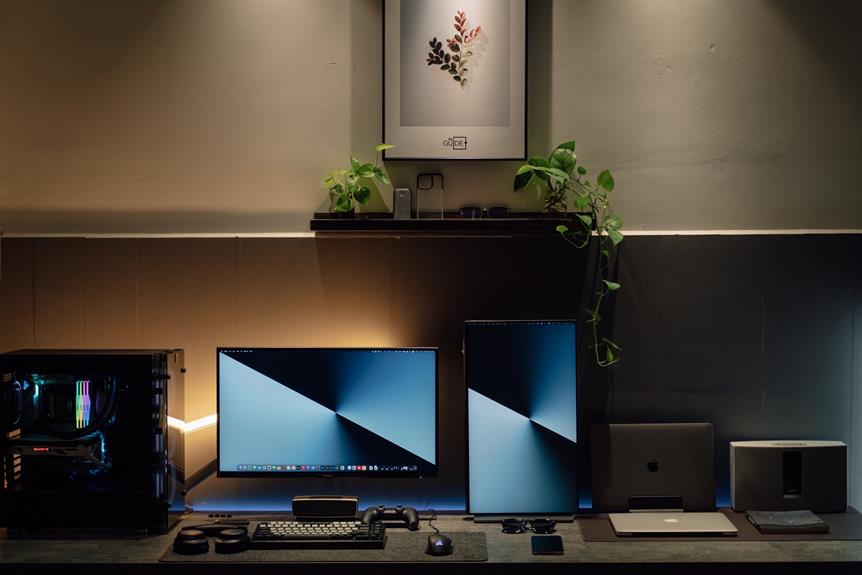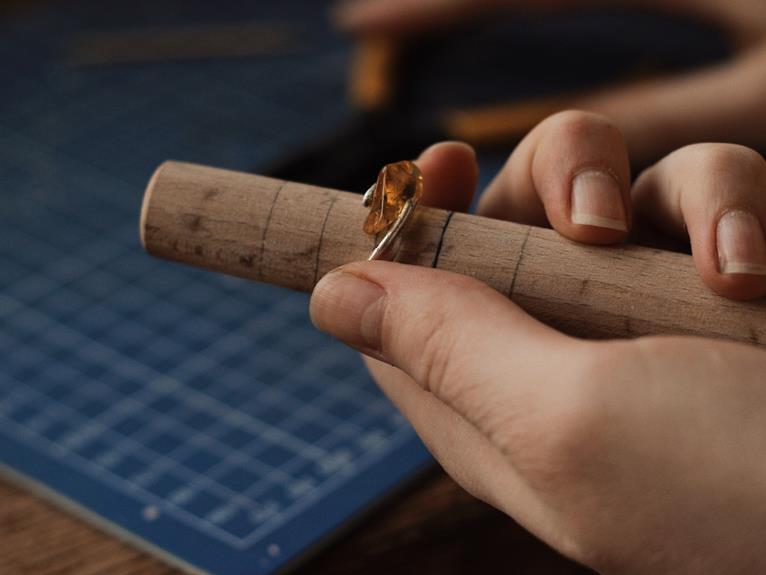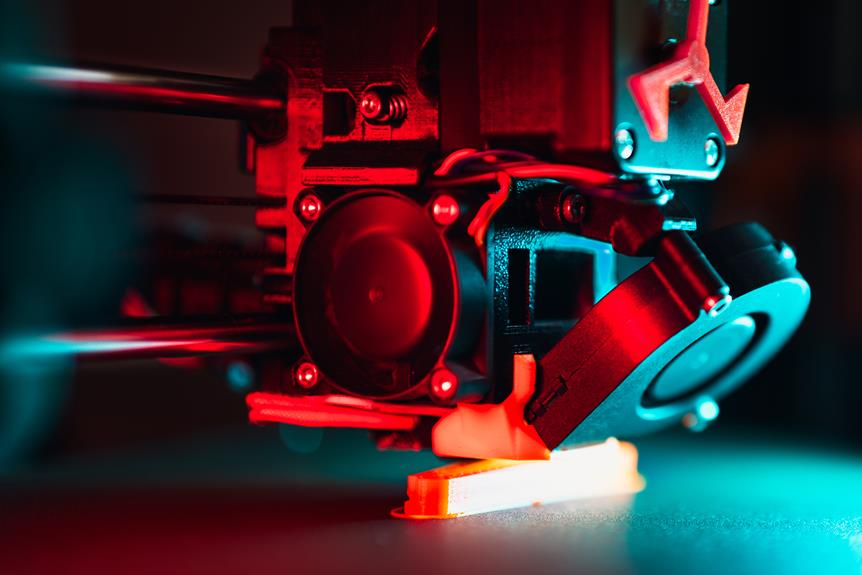DMLS 3D Printers: Expanding Horizons With Direct Metal Laser Sintering
Step into the future of additive manufacturing with DMLS 3D printers, where the boundaries of possibility are pushed beyond conventional limitations.
Harnessing the power of Direct Metal Laser Sintering (DMLS), this cutting-edge technology revolutionizes the way we create intricate metal structures.
From aerospace to healthcare, the applications of DMLS are vast and transformative.
In this article, we delve into the advancements, benefits, and challenges of DMLS, unveiling the innovations that shape the future of metal additive manufacturing.
Key Takeaways
- DMLS technology enables the creation of complex metal parts with precision and accuracy.
- DMLS 3D printers are used in industrial manufacturing to produce complex and customized metal parts.
- Advancements in DMLS printing have revolutionized the way metal parts are manufactured.
- Material compatibility and process optimization are crucial for successful DMLS printing.
The Power of Direct Metal Laser Sintering
With the advancements in technology, the power of Direct Metal Laser Sintering (DMLS) has significantly increased over time. DMLS technology, also known as metal printing, enables the creation of complex metal parts with a high level of precision and accuracy. This process involves the use of a laser to selectively melt metal powder particles, layer by layer, until the desired object is formed.
One of the key advantages of DMLS technology is its ability to produce parts with intricate geometries that would be difficult or impossible to achieve using traditional manufacturing methods. This opens up new possibilities for designers and engineers to create innovative and lightweight structures that are both functional and aesthetically appealing.
Moreover, DMLS allows for the production of parts in a wide range of metals, including stainless steel, titanium, aluminum, and even precious metals like gold and silver. This versatility makes DMLS suitable for a variety of applications across industries, such as aerospace, automotive, medical, and jewelry.
In addition to its versatility and ability to produce complex parts, DMLS offers the advantage of reduced lead times and costs compared to traditional manufacturing methods. This is because DMLS eliminates the need for tooling, which can be time-consuming and expensive.
Applications of DMLS 3D Printers
DMLS 3D printers have found widespread applications in industrial manufacturing. They offer the ability to produce complex and customized metal parts with high precision. These printers are particularly valuable in the production of medical devices. They allow for the creation of intricate and patient-specific implants and prosthetics.
The versatility and accuracy of DMLS technology make it a valuable tool in various industries. It enables advancements in manufacturing and healthcare.
Industrial Manufacturing Applications
The utilization of DMLS 3D printers in various industrial manufacturing applications has significantly increased in recent years. DMLS, or Direct Metal Laser Sintering, is a technology that allows for the creation of complex metal parts by selectively fusing metal powder using a high-powered laser. This process has revolutionized the manufacturing industry by enabling the production of intricate designs with high precision and accuracy.
DMLS 3D printers are widely used in industries such as aerospace, automotive, and tooling, where the demand for lightweight, durable, and customized parts is high. These printers offer the flexibility to produce parts with complex geometries, reducing the need for multiple components and assembly processes.
As we transition into the subsequent section about medical device production, it is important to note that DMLS 3D printers have also found applications in the healthcare sector, enabling the production of patient-specific implants and prosthetics.
Medical Device Production
The increasing adoption of DMLS 3D printers has opened up new possibilities in the production of advanced medical devices. These printers allow for the creation of complex and customized designs that were previously difficult or impossible to achieve using traditional manufacturing methods. The medical industry has quickly recognized the potential of DMLS 3D printing technology and has started using it for various applications. From surgical instruments to prosthetics, DMLS 3D printers are revolutionizing the way medical devices are produced. The ability to create intricate and precise designs allows for better patient outcomes and improved functionality of the devices. Additionally, the use of DMLS 3D printing reduces lead times and costs associated with traditional manufacturing processes. This table highlights some of the applications of DMLS 3D printers in the medical field:
| Application | Benefits |
|---|---|
| Surgical instruments | Customized designs, improved functionality |
| Prosthetics | Enhanced patient comfort, better fit |
| Implants | Customized designs, reduced lead times |
| Dental devices | Precise fit, improved aesthetics |
| Biomedical research | Rapid prototyping, cost-effective testing |
Material Compatibility in DMLS Printing
One important consideration in DMLS printing is the compatibility of materials used for the process. Material compatibility refers to the ability of a specific material to be successfully processed using the DMLS technique. This is crucial as it directly affects the quality, strength, and functionality of the final printed part.
In DMLS printing, the most commonly used materials are metal powders, such as stainless steel, aluminum, titanium, and cobalt-chrome alloys. These materials offer excellent mechanical properties, including high strength, good heat resistance, and corrosion resistance. However, not all materials are suitable for DMLS printing due to their physical and chemical characteristics.
For a material to be compatible with DMLS printing, it must have a high enough melting point to withstand the laser sintering process. Additionally, the material should have good flowability and uniform particle size distribution to ensure proper powder spreading and layer formation.
Furthermore, the compatibility of materials extends beyond their processing properties. It also includes post-processing considerations such as heat treatment, surface finishing, and machining. Different materials may require specific post-processing steps to achieve the desired properties and surface quality.
Exploring the Advancements in Metal Additive Manufacturing
Metal additive manufacturing has seen significant advancements in recent years, leading to improved manufacturing efficiency and enhanced design possibilities. These advancements have allowed for the production of complex geometries and intricate structures that were previously not feasible with traditional manufacturing methods.
The use of DMLS 3D printers, in particular, has played a crucial role in pushing the boundaries of metal additive manufacturing by offering high-resolution printing capabilities and the ability to work with a wide range of metal alloys.
Improved Manufacturing Efficiency
By harnessing the capabilities of advanced technology, additive manufacturing has revolutionized the efficiency of metal production processes.
Specifically, direct metal laser sintering (DMLS) 3D printers have played a significant role in enhancing manufacturing efficiency. DMLS allows for the creation of complex metal parts with intricate geometries that were previously impossible to produce using traditional methods.
The layer-by-layer additive manufacturing process reduces material waste and eliminates the need for expensive tooling. Additionally, DMLS enables the production of parts with improved mechanical properties and increased strength, making it a viable option for various industries, including aerospace, automotive, and healthcare.
The use of DMLS technology has streamlined manufacturing processes, resulting in faster production times and reduced costs. These advancements in manufacturing efficiency have paved the way for enhanced design possibilities, which will be discussed in the subsequent section.
Enhanced Design Possibilities
With the advancements in metal additive manufacturing, designers now have an array of new possibilities to explore and incorporate into their designs. The introduction of Direct Metal Laser Sintering (DMLS) 3D printers has significantly expanded the design horizons in the field of metal fabrication. This innovative technology allows for the creation of complex and intricate metal geometries that were previously unachievable through traditional manufacturing methods. By utilizing the layer-by-layer approach of additive manufacturing, DMLS enables designers to create parts with intricate internal structures, lightweight designs, and improved functionality. Additionally, the ability to fabricate parts with varying material properties and gradients opens up new avenues for creative and functional designs. The table below showcases some of the enhanced design possibilities made possible by DMLS technology:
| Enhanced Design Possibilities |
|---|
| Complex and intricate geometries |
| Lightweight designs |
| Internal structures |
| Functional gradients |
| Varying material properties |
These design advancements not only offer designers the freedom to explore innovative concepts, but also provide practical benefits in terms of improved performance and cost-effectiveness. Transitioning from the enhanced design possibilities of DMLS, the subsequent section will delve into the benefits of direct metal laser sintering technology.
Benefits of Direct Metal Laser Sintering Technology
One of the primary advantages of Direct Metal Laser Sintering (DMLS) technology is its ability to create complex geometries that are difficult or impossible to achieve through traditional manufacturing methods. This technology offers numerous benefits that make it an attractive option for a wide range of industries.
Firstly, DMLS enables the production of intricate and highly detailed parts with high precision and accuracy. The laser sintering process allows for the creation of complex shapes, internal cavities, and intricate features that would be challenging or impossible to achieve using traditional manufacturing techniques. This opens up new design possibilities and allows for the production of parts with improved functionality and performance.
Additionally, DMLS offers significant time and cost savings compared to traditional manufacturing methods. With DMLS, parts can be produced directly from digital designs, eliminating the need for costly and time-consuming tooling processes. This reduces lead times and allows for faster iteration and prototyping, ultimately speeding up the product development cycle.
Furthermore, DMLS technology supports a wide range of materials, including various metals and alloys. This versatility makes it suitable for applications in industries such as aerospace, automotive, medical, and engineering. DMLS can produce parts with excellent mechanical properties, ensuring the final product meets the required specifications and standards.
Innovations Shaping the Future of DMLS Printing
Advancements in technology are revolutionizing the field of DMLS printing, pushing the boundaries of what is possible in terms of speed, efficiency, and material capabilities. The innovations shaping the future of DMLS printing are poised to take the technology to new heights, offering new possibilities and opportunities for freedom in design and manufacturing.
Improved Speed and Efficiency:
- Faster laser scanning technologies are enabling quicker printing times, reducing production time and costs.
- Enhanced cooling systems and optimized build platforms are improving efficiency, allowing for continuous printing without delays.
Expanded Material Capabilities:
- New alloys and composites are being developed, offering a wider range of materials for DMLS printing.
- Improved powder handling systems and feedstock technologies are enabling the use of more complex and exotic materials, unlocking new design possibilities.
These innovations are not only improving the performance and capabilities of DMLS printers, but they are also opening up new opportunities for industries such as aerospace, automotive, and healthcare. As DMLS printing continues to evolve, it is important to address the challenges that come with this technology.
Transitioning to the next section, we will explore the ways in which these challenges can be overcome to fully realize the potential of direct metal laser sintering.
Overcoming Challenges in Direct Metal Laser Sintering
To successfully implement direct metal laser sintering, manufacturers must address and overcome various challenges that arise during the printing process. These challenges range from material selection and process optimization to post-processing and part quality control. One of the main challenges is the selection of suitable metal powders for the sintering process. Different metals have different characteristics and require specific parameters for successful printing. Additionally, the optimization of process parameters such as laser power, scanning speed, and layer thickness is crucial to achieve desired part quality and mechanical properties. Another challenge is the post-processing of the printed parts, which often require heat treatment, machining, or surface finishing to meet the desired specifications. Quality control is also a critical aspect, as it is important to ensure the dimensional accuracy, surface finish, and mechanical properties of the printed parts meet the required standards. Manufacturers must invest in advanced inspection techniques and equipment to validate the integrity of the printed parts. By addressing these challenges, manufacturers can overcome the obstacles and fully leverage the potential of direct metal laser sintering in various industries.
| Challenges | Description | Solution |
|---|---|---|
| Material Selection | Choosing suitable metal powders for the printing process | Extensive material testing and characterization |
| Process Optimization | Optimizing laser power, scanning speed, and layer thickness | Iterative process refinement and parameter optimization |
| Post-processing | Heat treatment, machining, and surface finishing of printed parts | Developing efficient post-processing techniques |
| Quality Control | Ensuring dimensional accuracy, surface finish, and mechanical properties | Implementing advanced inspection techniques and equipment |
| Part Quality | Meeting desired specifications for mechanical properties | Continuous improvement and feedback loop for part quality assurance |
Table 1: Challenges and Solutions in Direct Metal Laser Sintering.
Frequently Asked Questions
How Much Does a DMLS 3D Printer Typically Cost?
The cost of a DMLS 3D printer can vary depending on various factors such as the size, capabilities, and brand. Generally, DMLS 3D printers can range from a few thousand dollars to hundreds of thousands of dollars.
What Is the Average Print Speed of a DMLS 3D Printer?
The average print speed of a DMLS 3D printer depends on various factors such as the complexity of the design, the material being used, and the machine's specifications. However, DMLS printers are known for their precision and efficiency in producing intricate metal parts.
Are DMLS 3D Printers Capable of Producing Objects With Intricate Designs?
Yes, DMLS 3D printers are capable of producing objects with intricate designs. The direct metal laser sintering process allows for the precise melting and layering of metal powders, enabling the creation of complex and detailed structures with high accuracy.
What Types of Materials Can Be Used in DMLS Printing?
DMLS printing enables the use of a wide range of materials, including titanium, stainless steel, aluminum, and cobalt chrome. The versatility of these materials allows for the creation of complex and intricate designs with precision and durability.
How Long Does It Take to Learn How to Operate a DMLS 3D Printer?
The learning curve for operating a DMLS 3D printer can vary depending on an individual's prior experience and technical aptitude. However, with proper training and practice, one can become proficient in operating a DMLS 3D printer within a reasonable timeframe.
Conclusion
In conclusion, Direct Metal Laser Sintering (DMLS) technology has revolutionized the field of metal additive manufacturing, enabling the creation of complex and durable metal parts with high precision.
Its wide range of applications, compatibility with various materials, and numerous benefits make DMLS printers a valuable tool in industries such as aerospace, automotive, and healthcare.
As advancements continue to shape the future of DMLS printing, overcoming challenges and pushing the boundaries of what is possible, the potential for innovation in this field is limitless, like a metal phoenix rising from the ashes.








